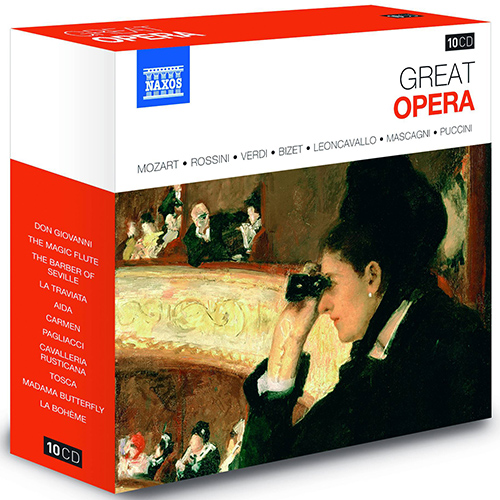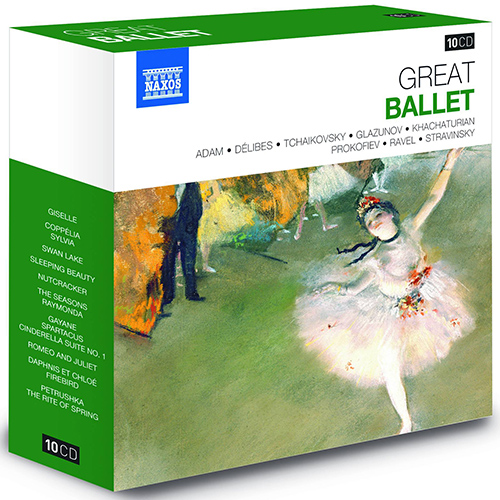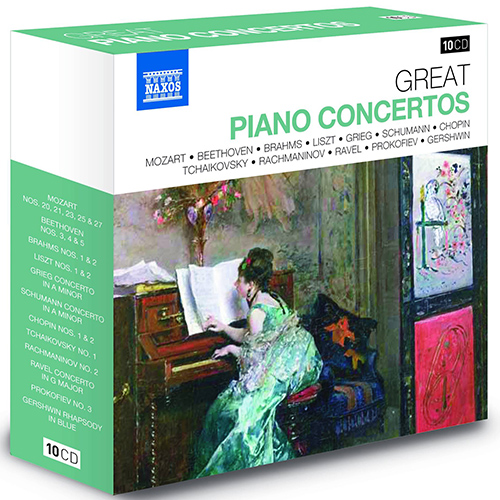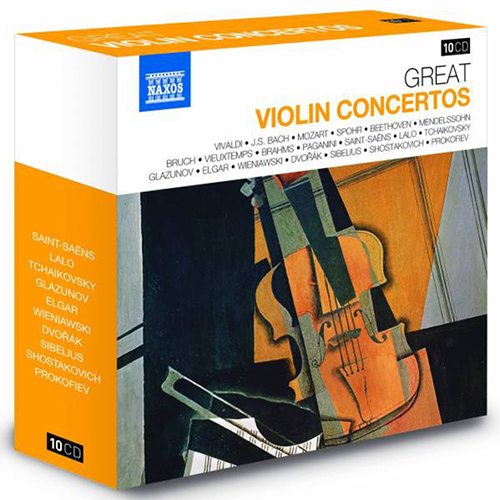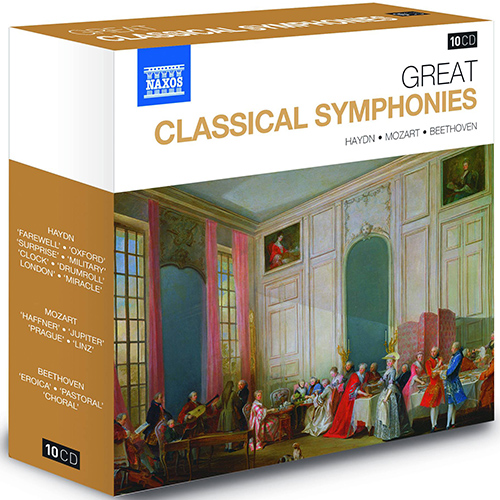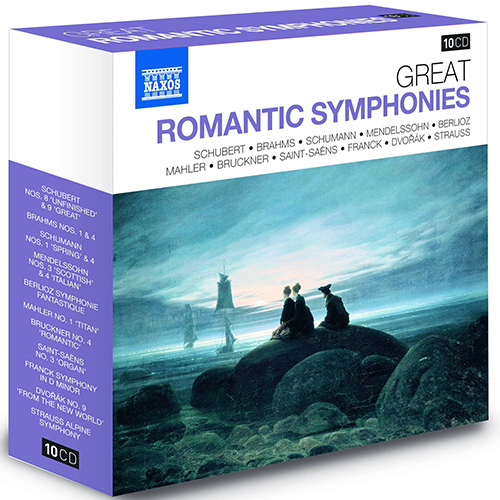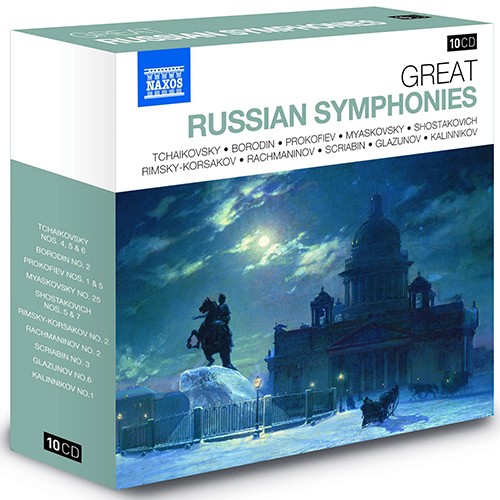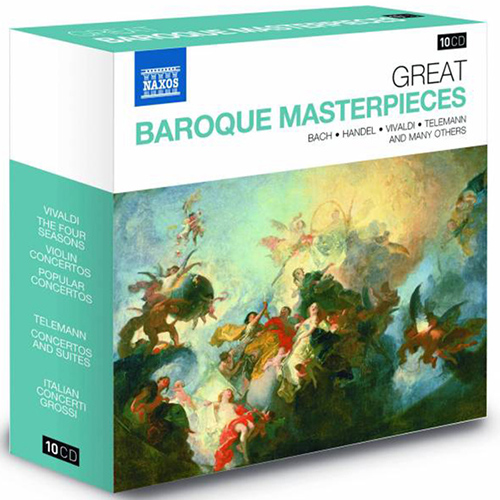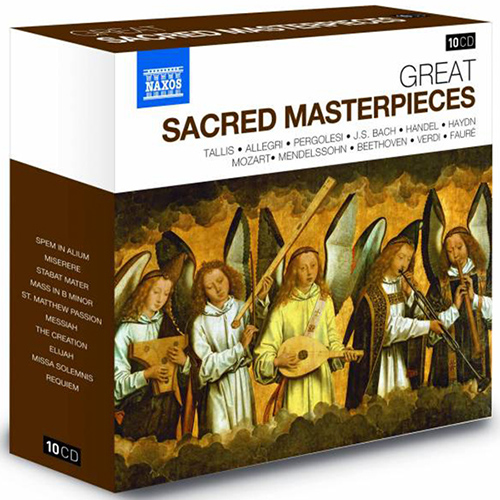The GREAT CLASSICS series from Naxos is the perfect introduction to myriad genres of classical music. Comprising both complete and compiled selections from the greatest works in the repertoire, the boxes are bursting with wonderful pieces of music, both recognizable and unfamiliar. The boxes take the listener on a thrilling tour of some of the world’s most dramatic musical media, encompassing music from six centuries and featuring sensational performers. All boxes come with a fascinating booklet with detailed information on the genre itself, chronological placement of each work, and a comprehensive study of the music. A fitting celebration of 25 years of superb music from Naxos, the world’s favourite classical label.
The booklets contain introductions to each genre plus notes for each work.
The very first operas were performed in Florence in the mid-1590s. Since then, musical styles have blossomed and evolved out of all recognition, yet opera continues to be heavily influenced by the political, social and cultural contexts surrounding its genesis. A collaborative enterprise, an opera brings together the works of composers, librettists, singers and designers alike, generating rich veins of public response and resulting in what is surely the most dramatic of all musical media. In this collection, we have brought together some of the most-loved operas, ranging from the elegance of Mozart’s Don Giovanni to the raw emotion of Mascagni’s Cavalleria Rusticana. The lighthearted japes of Rossini’s Barber of Seville contrast royally with the pomp and spectacle of Verdi’s Aida, whilst the sultry allure of Bizet’s Carmen is the perfect foil to the lachrymose tragedy of Puccini’s La Bohème. This box is sure to entice any listener further into the magical world of opera.
GREAT OPERA includes Highlights CDs from the following operas:
CD 1 Mozart Don Giovanni
CD 2 Mozart Die Zauberflöte (The Magic Flute)
CD 3 Rossini Il barbiere di Siviglia (The Barber of Seville)
CD 4 Verdi La traviata
CD 5 Verdi Aida
CD 6 Bizet Carmen
CD 7 Mascagni Cavalleria Rusticana • Leoncavallo Pagliacci
CD 8 Puccini Tosca
CD 9 Puccini Madama Butterfly
CD 10 Puccini La Bohème
Ballet was born from the late Renaissance movement in Europe, combining the classical skills of music, dance and drama. Its origins can be traced back to the dance traditions of the nobility in the French and Italian courts of the fifteenth century. The creation of classical ballet as we know it was developed under the auspices of Louis XIV, and was then further refined in France and Russia in the nineteenth century into the hugely influential and highly skilled concert dance form with which we are familiar today. Fittingly this collection starts in France, with one of the most haunting and memorable examples of the ballet form: Adam’s Giselle. We are then swept along in a whirlwind tour of some of the greatest Russian ballets by such great composers as Prokofiev, Khachaturian and Shostakovich, while no ballet anthology would be complete without Tchaikovsky’s three Romantic masterpieces Swan Lake, Sleeping Beauty and The Nutcracker. From Delibes to Stravinsky, this collection amply demonstrates why ballet remains one of the most loved musical genres.
GREAT BALLET includes Highlights CDs from the following ballets:
CD 1 Adam Giselle
CD 2 Delibes Coppélia / Sylvia
CD 3 Tchaikovsky Swan Lake
CD 4 Tchaikovsky Sleeping Beauty
CD 5 Tchaikovsky Nutcracker
CD 6 Glazunov The Seasons • Raymonda
CD 7 Khachaturian Gayane • Spartacus • Prokofiev Cinderella
CD 8 Prokofiev Romeo and Juliet
CD 9 Ravel Daphnis et Chloé • Stravinsky Firebird
CD 10 Stravinsky Petrushka • The Rite of Spring
At the very heart of a concerto is the interplay and contrast of a solo instrument within a larger instrumental ensemble. The natural progression from the Baroque concerto grosso, the concerto as we know it was fully established as a concert staple in the eighteenth century, and many works dating from this period are still a key part of the repertoire today. The opportunity for dazzling virtuosic display from the soloist has resulted in the concerto becoming a vital musical force both on the concert platform and in the audience arena.
The most important composer in the development of the early piano concerto was Mozart, whose masterly compositions for the instrument paved the way for expansion of the form by composers such as Beethoven, Schumann, Brahms and Grieg. In the Romantic era, composers such as Rachmaninov and Tchaikovsky lent a distinctly Russian fluency and passion to the idiom, whilst no pianistic survey would be complete without the transcendent concertos of those great piano masters, Chopin and Liszt. The twentieth-century transformed the piano concerto yet further with splendid offerings from a delicate Ravel, fiery Prokofiev and jazzy Gershwin to name but a few.
GREAT PIANO CONCERTOS includes the following concertos:
CD 1 Mozart Piano Concertos Nos. 20 & 21
CD 2 Mozart Piano Concertos Nos. 23 & 25
CD 3 Beethoven Piano Concertos Nos. 3 & 4
CD 4 Beethoven Piano Concerto No. 5 • Mozart Piano Concerto No. 27
CD 5 Brahms Piano Concerto No. 1 • Liszt Piano Concerto No. 1
CD 6 Brahms Piano Concerto No. 2 • Liszt Piano Concerto No. 2
CD 7 Grieg Piano Concerto • Schumann Piano Concerto
CD 8 Chopin Piano Concertos Nos. 1 & 2
CD 9 Tchaikovsky Piano Concerto No. 1 • Rachmaninov Piano Concerto No. 2
CD 10 Ravel Piano Concerto in G Major • Prokofiev Piano Concerto No. 3 • Gershwin Rhapsody in Blue
The violin concerto owes a great deal of its development to the technical achievement of performers, and to this day many works are renowned for their fierce technical demands. Indeed, many composers who have written for the instrument were superlative players themselves – Wieniawski and Paganini among them. The fascinating history and capabilities of the instrument can be traced through the compositions contained herein; from the gossamer threads of Vivaldi to the exhilarating fireworks of Prokofiev, via the lilting swagger of Lalo and Saint-Saëns and nationalistic panache of Sibelius and Glazunov.
GREAT VIOLIN CONCERTOS includes the following concertos:
CD 1 Vivaldi Four Seasons • J.S. Bach Violin Concertos in A Minor & E Major
CD 2 Mozart Violin Concertos Nos. 4 & 5 • Spohr Concerto No. 8
CD 3 Beethoven Violin Concerto in D Major • Mozart Violin Concerto No. 3
CD 4 Mendelssohn Violin Concerto in E Minor • Bruch Violin Concerto No. 1 • Vieuxtemps Violin Concerto No. 5
CD 5 Brahms Violin Concerto in D Major • Paganini Violin Concerto No. 1
CD 6 Saint-Saëns Violin Concerto No. 3 • Lalo Symphonie Espagnole
CD 7 Tchaikovsky Violin Concerto in D Major • Glazunov Violin Concerto in A Minor
CD 8 Elgar Violin Concerto in B Minor • Wieniawski Violin Concerto No. 2
CD 9 Dvořák Violin Concerto in A Minor • Sibelius Violin Concerto in D Minor
CD 10 Shostakovich Violin Concerto No. 1 • Prokofiev Violin Concerto No. 1
The word ‘symphony’ is used to describe an extended orchestral composition in Western classical music. By the eighteenth century the Italianate opera sinfonia – musical interludes between operas or concertos – had assumed the structure of three contrasting movements, and it is this form that is often considered as the direct forerunner of the orchestral symphony. With the rise of established professional orchestras, the symphony assumed a more prominent place in concert life between 1790 and 1820 until it eventually came to be regarded by many as the yardstick by which one would measure a composer’s achievement.
Without doubt, the most important symphonists of the latter part of the eighteenth century are Haydn and Mozart. Often credited with expanding the symphonic form to the four movements we are familiar with today, these two composers are together responsible for over 160 symphonies including those commonly regarded as the apex of the Classical symphonic form – Haydn’s London symphonies and Mozart’s Jupiter and Linz. A few years later, Beethoven dramatically expanded the symphony, in so doing forming the bridge between the Classical and Romantic eras. His Eroica symphony has a scale and emotional range that sets it apart from earlier works, while his Symphony No. 5 is arguably the most famous symphony ever written.
GREAT CLASSICAL SYMPHONIES includes the following symphonies:
CD 1 Haydn Symphonies Nos. 45 ‘Farewell’, 88 and 92 ‘Oxford’
CD 2 Haydn Symphonies Nos. 94 ‘Surprise’, 100 ‘Military’ and 101 ‘Clock’
CD 3 Haydn Symphonies Nos. 95, 103 ‘Drumroll’ and 104 ‘London’
CD 4 Haydn Symphonies Nos. 96 ‘Miracle’, 98 and 102
CD 5 Mozart Symphonies Nos. 25, 35 ‘Haffner’ and 41 ‘Jupiter’
CD 6 Mozart Symphonies Nos. 38 ‘Prague’, 39 and 40
CD 7 Mozart Symphonies Nos. 29, 34 and 36 ‘Linz’
CD 8 Beethoven Symphonies Nos. 3 ‘Eroica’ and 8
CD 9 Beethoven Symphonies Nos. 5 and 6 ‘Pastoral’
CD 10 Beethoven Symphony No. 9 ‘Choral’
The nineteenth century brought various changes to the symphonic form. Although both inspired by Beethoven, Berlioz’s experiments with instrumental colour and orchestral size are a world away from the colossal symphonies of Brahms. Composers such as Mahler and Bruckner pushed the traditional symphonic landscapes to their limits, in sharp contrast to the uplifting Classically-based symphonies of Mendelssohn and Schubert. The nationalistic flavours apparent in the programme symphonies of Schumann, Strauss and Dvořák exemplify the way in which the symphonic form flourished in the Romantic era, whilst the visceral impact of the Gallic panache is typified by the symphonies of Franck and Saint-Saëns.
GREAT ROMANTIC SYMPHONIES includes the following symphonies:
CD 1 Schubert Symphonies Nos. 8 and 9
CD 2 Brahms Symphony No. 1 • Schumann Symphony No. 1
CD 3 Brahms Symphony No. 4 • Schumann Symphony No. 4
CD 4 Mendelssohn Symphonies Nos. 3 and 4
CD 5 Berlioz Symphonie Fantastique • Benvenuto Cellini • Roman Carnival
CD 6 Mahler Symphony No. 1
CD 7 Bruckner Symphony No. 4
CD 8 Saint-Saëns Symphony No. 3 • Franck Symphony in D Minor
CD 9 Dvořák Symphony No. 9 • Symphonic Variations
CD 10 Strauss Alpine Symphony • Don Juan
The symphony came late to Russia. The first attempts at a Russian Nationalist symphony were made in the late nineteenth-century by Balakirev and his acolytes, Borodin and Rimsky-Korsakov as well as by Tchaikovsky, whose symphonies (despite his European leanings) have a distinctly Russian flavour. In their wake followed numerous composers, from Glazunov to Myaskovsky, similarly instilling their music with the melodies of their homeland. In the years that followed Russian politics had an unmistakable impact on the Russian symphonists, as Rachmaninov and Prokofiev (among others) went into exile whilst composers such as Shostakovich vented their political frustrations through the medium of music – his Leningrad Symphony being a prime example.
GREAT RUSSIAN SYMPHONIES includes the following symphonies:
CD 1 Tchaikovsky Symphony No. 4 • Borodin Symphony No. 2
CD 2 Tchaikovsky Symphony No. 5 • Romeo and Juliet
CD 3 Tchaikovsky Symphony No. 6 • 1812 Overture
CD 4 Prokofiev Symphony No.5 • Myaskovsky Symphony No. 25
CD 5 Shostakovich Symphony No. 5 • Prokofiev Symphony No.1
CD 6 Shostakovich Symphony No. 7
CD 7 Rimsky-Korsakov Symphony No. 2 • Sheherazade
CD 8 Rachmaninov Symphony No. 2 • The Rock
CD 9 Scriabin Symphony No.3 • Le Poème de I’extase
CD 10 Glazunov Symphony No.6 • Kalinnikov Symphony No.1
Baroque music describes the period in Western classical music dating from approximately 1600 to 1750. The Baroque period saw the development of functional tonality, as well as new instrumental playing techniques and musical notation. It was during this time that opera was established as a musical genre, and the period also saw the expansion of the range and complexity of instrumental performance.
This collection concentrates on the instrumental music of the period. No survey of the Baroque would be complete without the music of J.S. Bach, whose Brandenburg concertos are commonly regarded as the apex of Baroque music. The radiant concertos of Vivaldi demonstrate the exhilarating range of instrumental colour that flourished at this time and contrast with the orchestral zest of Handel’s robust Water Music. From classical favourites such Pachelbel’s Canon and Albinoni’s Adagio, to Concerti Grossi from composers as diverse as Corelli, Handel, Locatelli and Geminiani, this set is the perfect compilation of works from this most fascinating of eras.
GREAT BAROQUE MASTERPIECES includes the following masterpieces:
CD 1 Baroque Favourites (includes works by Handel, Marcello, J.S. Bach, Corelli, Pachelbel, Torelli, Albinoni, Sammartini, Locatelli, Geminiani, Albinoni)
CD 2 J.S. Bach Brandenburg Concertos Nos. 1, 2, 3 & 6
CD 3 J.S. Bach Brandenburg Concertos Nos. 4 & 5 • Concertos in A Minor and F Major
CD 4 J.S. Bach Orchestral Suites Nos. 1–4
CD 5 Handel Water Music • Fireworks Music
CD 6 Handel Concerti Grossi Op. 3 No. 2, Op. 6 Nos. 7 & 12 • Organ Concerto ‘The Cuckoo & The Nightingale’ • Organ Concerto Op. 4 No. 4
CD 7 Vivaldi The Four Seasons, Violin Concerti RV 253, RV 180, RV 362
CD 8 Vivaldi Violin Concerto RV 356 • Guitar Concerto in D Major • Flute Concerto RV 428 • Flautino Concerto in C Major • Oboe Concerto, RV 454 • Cello Concerto, RV 406 • Bassoon Concerto, RV 502
CD 9 Telemann Viola Concerto in G Major • Recorder Suite in A Minor • Musique de table: Concerto in F Major for three violins • Concerto for two horns and strings
CD 10 Italian Concerti Grossi (includes works by Sammartini, Albinoni, Vivaldi, Locatelli, Manfredini, Corelli, Geminiani, A. Scarlatti)
Music has always had an important part to play in religious ritual. Records show that plainchant existed from as early as 3 A.D., and centuries later it was to provide a foundation for early polyphony and for the great flowering of Church music in the Renaissance, including the transcendent works of Tallis and Allegri. J.S. Bach wrote most of his music for the Lutheran Church, including the magnificent Mass in B Minor and the two Passions. Handel also contributed to religious music in England, with the creation of oratorios such as Messiah which, when witnessed by Haydn years later, inspired him to write The Creation. In the nineteenth century the form flowered again with Felix Mendelssohn, himself responsible for bringing many sacred works by J.S. Bach back to musical prominence. He completed Elijah in 1846; a work that, although modeled on the Handelian oratorio, clearly reflected in its lyricism and use of orchestral and choral colour Mendelssohn’s own genius as an early Romantic composer. Particular attention has been given over the years to settings of the Requiem Mass. This collection includes three versions – from contemplative Mozart, to awesome Verdi, and sublime Fauré. Without doubt, in the years to come, religion will continue to be the driving inspirational force behind many a composition.
GREAT SACRED MASTERPIECES includes the following masterpieces:
CD 1 Favourite Sacred Masterpieces (includes Tallis Spem in alium, Allegri Miserere, Pergolesi Stabat Mater)
CD 2 J.S. Bach Mass in B Minor (Highlights)
CD 3 J.S. Bach St. Matthew Passion (Highlights)
CD 4 Handel Messiah (Highlights)
CD 5 Haydn The Creation (Highlights)
CD 6 Mozart Requiem
CD 7 Mendelssohn Elijah (Highlights)
CD 8 Beethoven Missa Solemnis
CD 9 Verdi Requiem (Highlights)
CD 10 Fauré Requiem

